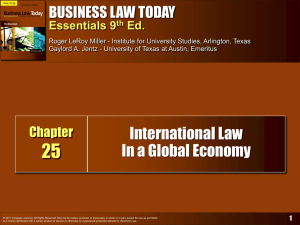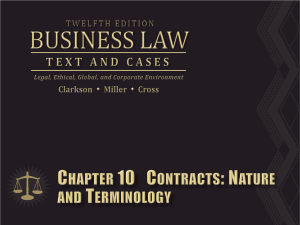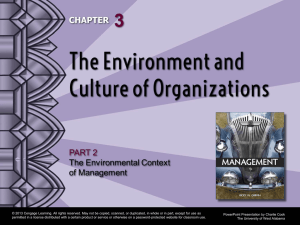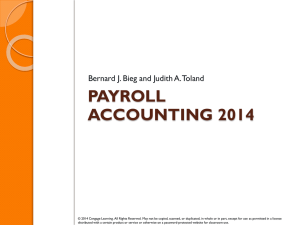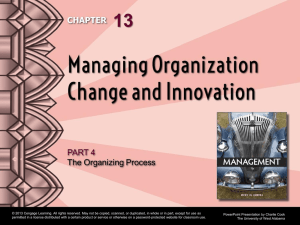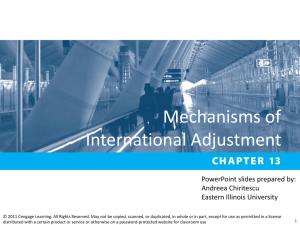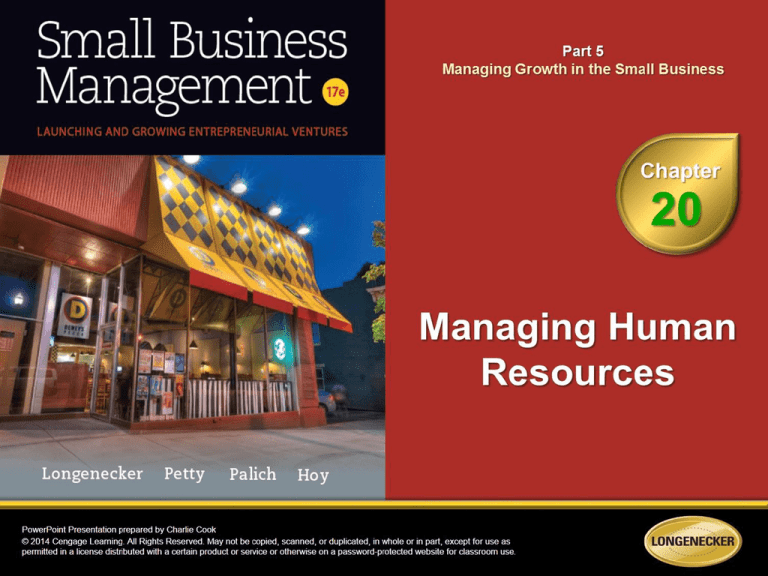
1. Explain the importance of employee recruitment
and list some useful sources for finding suitable
applicants.
2. Identify the steps in evaluating job applicants.
3. Describe the roles of training and development for both
managerial and nonmanagerial employees.
4. Explain the various types of compensation plans,
including the use of incentive plans.
5. Discuss the human resource issues of co-employment,
legal protection, labor unions, and the formalizing
of employer–employee relationships.
© 2014 Cengage Learning. All Rights Reserved. May not be copied, scanned, or duplicated, in whole or in part, except for use as
permitted in a license distributed with a certain product or service or otherwise on a password-protected website for classroom use.
20–2
Recruiting Personnel
• The Need for Quality Employees
Employee performance directly or indirectly affects
the capability of the firm to service customer needs.
Employee performance affects profitability.
Payroll costs affect firm’s bottom line.
Quality of employees determines the long-term
competitive potential of the firm.
© 2014 Cengage Learning. All Rights Reserved. May not be copied, scanned, or duplicated, in whole or in part, except for use as
permitted in a license distributed with a certain product or service or otherwise on a password-protected website for classroom use.
20–3
The Lure of Entrepreneurial Firms
• Advantages of Employment in Small Firms
Quicker movement to decision-making levels of
management
Greater managerial freedom
More opportunities for broad-based managerial
experience
Flexibility in work scheduling
and job sharing
© 2014 Cengage Learning. All Rights Reserved. May not be copied, scanned, or duplicated, in whole or in part, except for use as
permitted in a license distributed with a certain product or service or otherwise on a password-protected website for classroom use.
20–4
Sources of Employees
Internet
recruiting
Walk-ins
Schools
Public employment
offices
Private employment
agencies
Executive
search firms
Employee
referrals
Help-wanted
advertising
Temporary help
agencies
© 2014 Cengage Learning. All Rights Reserved. May not be copied, scanned, or duplicated, in whole or in part, except for use as
permitted in a license distributed with a certain product or service or otherwise on a password-protected website for classroom use.
20–5
Diversity in the Workforce
• Workforce Diversity
Differences among employees in terms of such
dimensions as gender, age, and race.
Diversity is increasing with higher proportions of
women, older workers, and racial minorities entering
the workforce.
© 2014 Cengage Learning. All Rights Reserved. May not be copied, scanned, or duplicated, in whole or in part, except for use as
permitted in a license distributed with a certain product or service or otherwise on a password-protected website for classroom use.
20–6
Job Descriptions
• Job Description
A summary outlining the essential duties required by
a specific job
Aids in personnel recruitment.
Helps focus employees on their work.
Provides direction in training.
Serves as the basis for performance review.
• Job Specification
A list of the knowledge, skills and abilities needed by
the job holder to successfully perform a specific job
Aids in selecting the most qualified job applicant.
© 2014 Cengage Learning. All Rights Reserved. May not be copied, scanned, or duplicated, in whole or in part, except for use as
permitted in a license distributed with a certain product or service or otherwise on a password-protected website for classroom use.
20–7
Evaluating Prospects and
Selecting Employees
Steps in Recruiting Employees
1
Use application forms
2
Interview the applicant
3
Check references and background information
4
Test the applicant
5
Require physical examinations
© 2014 Cengage Learning. All Rights Reserved. May not be copied, scanned, or duplicated, in whole or in part, except for use as
permitted in a license distributed with a certain product or service or otherwise on a password-protected website for classroom use.
20–8
Evaluating Job Applicants
Telephone
Screening
Face-to-Face
Interviews
Background
Checks
Credit
Checks
Drug
Screening
Personality and
Behavior Testing
Skills
Assessment
Motor Vehicle
Record Checks
Physical
Examinations
© 2014 Cengage Learning. All Rights Reserved. May not be copied, scanned, or duplicated, in whole or in part, except for use as
permitted in a license distributed with a certain product or service or otherwise on a password-protected website for classroom use.
20–9
Testing the Applicant
• Job-Related Testing
The U.S. Supreme Court has upheld the Equal
Employment Opportunity Commission’s requirement
that any test used in making employment decisions
must be job-related.
• Validity
The extent to which a test assesses true job
performance ability.
• Reliability
The consistency of a test in measuring job
performance ability.
© 2014 Cengage Learning. All Rights Reserved. May not be copied, scanned, or duplicated, in whole or in part, except for use as
permitted in a license distributed with a certain product or service or otherwise on a password-protected website for classroom use.
20–10
Training and Developing Employees
• Purposes of Training and Development
Prepare new recruit to perform the duties of the job.
Improve the performance of current employees.
Prepare employees for career advancement.
Improve morale of current employees.
Serve as an inducement to potential applicants.
© 2014 Cengage Learning. All Rights Reserved. May not be copied, scanned, or duplicated, in whole or in part, except for use as
permitted in a license distributed with a certain product or service or otherwise on a password-protected website for classroom use.
20–11
Types of Training and Development
Training and Development
Development of
Managers and
Professionals
Training of
Nonmanagerial
Employees
Orientation of
New and Current
Personnel
© 2014 Cengage Learning. All Rights Reserved. May not be copied, scanned, or duplicated, in whole or in part, except for use as
permitted in a license distributed with a certain product or service or otherwise on a password-protected website for classroom use.
Training to
Improve
Quality
20–12
20.1
Steps in Job Instruction Training
PREPARE EMPLOYEES
• Put employees at ease.
PRESENT THE
OPERATIONS
• Place them in appropriate
jobs.
• Tell, show, and illustrate
the task.
• Find out what they know.
• Stress key points.
• Get them interested in
learning
• Instruct clearly and
completely
TRY OUT PERFORMANCE
FOLLOW UP
• Have employees perform
the task.
• Check on employees
frequently.
• Have them tell, show,
and explain.
• Tell them how to obtain
help.
• Ask employees questions
and correct any errors.
• Encourage questions.
© 2014 Cengage Learning. All Rights Reserved. May not be copied, scanned, or duplicated, in whole or in part, except for use as
permitted in a license distributed with a certain product or service or otherwise on a password-protected website for classroom use.
20–13
From Training to Implementation
• Suggestions for Training Efforts:
Put it (an employee’s personal action plan) on paper
Measure results (increased productivity) of training
Involve peers to support and reinforce training
Involve supportive superiors
Provide access to experts
to fill in training gaps
© 2014 Cengage Learning. All Rights Reserved. May not be copied, scanned, or duplicated, in whole or in part, except for use as
permitted in a license distributed with a certain product or service or otherwise on a password-protected website for classroom use.
20–14
Development of Managerial and
Professional Employees
• Determining the need for training
• Creating a plan for training
• Setting a timetable for training
• Providing employee counseling
© 2014 Cengage Learning. All Rights Reserved. May not be copied, scanned, or duplicated, in whole or in part, except for use as
permitted in a license distributed with a certain product or service or otherwise on a password-protected website for classroom use.
20–15
Compensation and Incentives
for Employees
• Wage or Salary Levels
Competitive compensation
Time- or output-based compensation
• Financial Incentives
Commission systems
Piecework
Group incentives and team awards
Bonus and profit-sharing plans
© 2014 Cengage Learning. All Rights Reserved. May not be copied, scanned, or duplicated, in whole or in part, except for use as
permitted in a license distributed with a certain product or service or otherwise on a password-protected website for classroom use.
20–16
Compensation and Incentives
for Employees (cont’d)
• Performance-Based Compensation Plans
Keys to developing an effective bonus plan:
Set
attainable goals.
Include
Keep
employees in planning.
updating goals.
© 2014 Cengage Learning. All Rights Reserved. May not be copied, scanned, or duplicated, in whole or in part, except for use as
permitted in a license distributed with a certain product or service or otherwise on a password-protected website for classroom use.
20–17
Stock Incentives
• Employee Stock Ownership Plans (ESOPs)
Plans through which a firm is sold either in part or in
total to its employees.
Employees’ performance is motivated by
their sharing of ownership in the firm.
Owners can cash out and withdraw
without selling to outsiders.
ESOPs offer tax advantages to
owners and employees.
© 2014 Cengage Learning. All Rights Reserved. May not be copied, scanned, or duplicated, in whole or in part, except for use as
permitted in a license distributed with a certain product or service or otherwise on a password-protected website for classroom use.
20–18
Compensation and Incentives
for Employees (cont’d)
• Employee Benefits
Supplements to compensation designed to
be attractive and beneficial to employees.
Benefits are a substantial portion of payroll costs.
Small firms tend to provide fewer benefits.
Use of flexible benefit plans is growing.
Small firms are increasingly outsourcing the
administration of their benefits programs.
© 2014 Cengage Learning. All Rights Reserved. May not be copied, scanned, or duplicated, in whole or in part, except for use as
permitted in a license distributed with a certain product or service or otherwise on a password-protected website for classroom use.
20–19
Special Issues in HRM
• Co-Employment Agreements
Outsourcing administrative processes to a fee-for-
services organization (PEO) that handles payroll and
benefit administration for those employees.
Allows small firms to provide improved employee benefits.
Makes small firms subject to additional government
regulations affecting larger firms.
Professional Employment Organization (PEO)
A company that sets up co-employment agreements,
assisting businesses with the administrative demands of
keeping employees on their payrolls.
© 2014 Cengage Learning. All Rights Reserved. May not be copied, scanned, or duplicated, in whole or in part, except for use as
permitted in a license distributed with a certain product or service or otherwise on a password-protected website for classroom use.
20–20
Legal Protection of Employees
• Civil Rights Act (1964) as amended
Legislation prohibiting discrimination based on race,
color, religion, sex, or national origin.
Applies to all employers of more than 15 people.
• Americans with Disabilities Act (1990)
Legislation prohibiting discrimination against persons
with disabilities; requires firms make “reasonable
accommodations” in the employment of disabled
persons.
© 2014 Cengage Learning. All Rights Reserved. May not be copied, scanned, or duplicated, in whole or in part, except for use as
permitted in a license distributed with a certain product or service or otherwise on a password-protected website for classroom use.
20–21
Legal Protection of Employees (cont’d)
• Sexual harassment policy guidelines:
Establish clear policies and procedures regarding
sexual harassment in the workplace.
Require employees to report incidents of harassment
to management immediately.
Investigate any and all complaints of sexual
harassment fairly and thoroughly.
Take appropriate action against violators and
maintain claimant confidentiality.
If a lawsuit is to be filed, contact an attorney.
© 2014 Cengage Learning. All Rights Reserved. May not be copied, scanned, or duplicated, in whole or in part, except for use as
permitted in a license distributed with a certain product or service or otherwise on a password-protected website for classroom use.
20–22
Legal Protection of Employees (cont’d)
• Occupational Safety and Health Act (1970)
Legislation that regulates the safety of workplaces
and work practices.
Created the Occupational Safety and Health
Administration (OSHA) to establish and enforce
health and safety standards.
• Fair Labor Standards Act (FLSA)
Federal law that establishes a minimum wage and
provides for overtime pay for more than 40 hours per
week.
© 2014 Cengage Learning. All Rights Reserved. May not be copied, scanned, or duplicated, in whole or in part, except for use as
permitted in a license distributed with a certain product or service or otherwise on a password-protected website for classroom use.
20–23
Legal Protection of Employees (cont’d)
• Family and Medical Leave Act (1993)
Firms must provide up to 12 weeks of unpaid leave
for childbirth and other family needs.
Firms must continue health-care coverage during the
leave and guarantee that employee can return to the
same or a comparable job.
• Labor Unions
Participating in collective bargaining for labor
contracts.
Implementing HR policies to minimize employees’
desire for organization and representation.
© 2014 Cengage Learning. All Rights Reserved. May not be copied, scanned, or duplicated, in whole or in part, except for use as
permitted in a license distributed with a certain product or service or otherwise on a password-protected website for classroom use.
20–24
Special Issues in HRM (cont’d)
• Formalizing Employer-Employee Relationships
Standardizing personnel policies and procedures
Avoiding the paralytic effects of excessive regulation while
avoiding the increasing costs of informality
Establishing a performance review system based on
SMART goals:
Specific
Measurable
Achievable
Realistic
Time-bound
© 2014 Cengage Learning. All Rights Reserved. May not be copied, scanned, or duplicated, in whole or in part, except for use as
permitted in a license distributed with a certain product or service or otherwise on a password-protected website for classroom use.
20–25
Special Issues in HRM (cont’d)
• The Need for a Human Resource Manager
Conditions favoring appointment of an HR manager:
A substantial number of employees (100 or more)
Unionized employees
High labor turnover rate
Need to recruit and select skilled/professional employees
Considerable need to train supervisors or operative
employees
Poor employee morale
Strong competition for personnel
© 2014 Cengage Learning. All Rights Reserved. May not be copied, scanned, or duplicated, in whole or in part, except for use as
permitted in a license distributed with a certain product or service or otherwise on a password-protected website for classroom use.
20–26
Key Terms
behavioral interview
Civil Rights Act
co-employment
employee benefits
employee training
Fair Labor Standards Act (FLSA)
Family and Medical Leave Act
flexible benefit programs (cafeteria
plans)
headhunter
human resource management
(HRM)
job description
Job Instruction Training
job specification
management development
Occupational Safety and Health Act
on-the-job training
piecework
professional employer organization
(PEO)
reliability
validity
workforce diversity
© 2014 Cengage Learning. All Rights Reserved. May not be copied, scanned, or duplicated, in whole or in part, except for use as
permitted in a license distributed with a certain product or service or otherwise on a password-protected website for classroom use.
20–27


